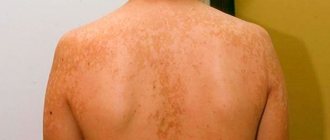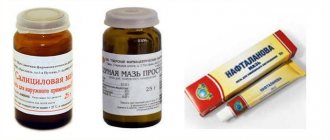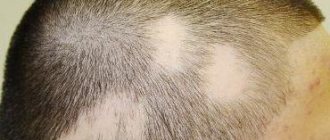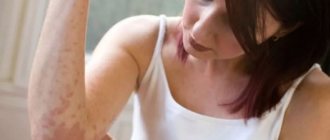Pityriasis versicolor in humans: symptoms and treatment with ointments
Pityriasis versicolor (colored, multi-colored lichen) is a recurrent skin disease of a fungal nature, which affects only the outer layer of the skin (the upper stratum corneum of the epidermis), which has direct contact with the environment. Doctors note that the peak of the disease occurs in the hot summer, which is why this disease is often called “sun fungus.” Mostly young people suffer from pityriasis versicolor; it is much less common in children and the elderly.
The causative agent of tinea versicolor in humans is yeast-like fungi of the genus Pityrosporum, which can exist in three different forms, transforming into one another. The disease is considered conditionally contagious, that is, the fungus can be transmitted through contact with a sick person and his personal belongings, but this does not mean that the infected person will necessarily get sick.
What it is?
Pityriasis versicolor is a long-term (chronic) fungal infection of the stratum corneum of the epidermis. A common (slang) name that can be found at resorts is “solar fungus.” It is necessary to distinguish the disease from Vitiligo, pink zhibert and syphilitic roseola.
The name “lichen” (Lichen) has been known since the time of Hippocrates; it includes many skin diseases, which are characterized by the formation of colored spots and peeling. The causative agent of pityriasis versicolor was described by G. Robin in 1853, and in 1951 M. Gordon identified round and oval forms of the pathogen, both in places of pityriasis versicolor rashes and within healthy skin, classifying it as a yeast-like fungus.
Are there predisposing factors?
The fungus, which is the causative agent of pityriasis versicolor, can live on the skin for quite a long time without appearing outwardly. In order for its signs to be revealed, a push is needed. Such an impetus for the active development of fungus can be endocrine pathologies, increased sweating, weakened immunity, stressful situations for the skin that disrupt the protective function of the skin - solarium, excessive exposure to the sun, frequent use of antibacterial soaps and shower gels.
IMPORTANT!
The thought of self-medicating pityriasis versicolor is tempting. It seems so simple - I bought antifungal ointment, did it as indicated in the instructions for use, and it’s done. Alas! Without an individual, qualified course of therapy, the fungus will simply adapt to the drugs used, and further treatment will be complicated. Unsystematic or symptomatic self-treatment is highly undesirable.
Causes of infection
The causative agent of the disease is a yeast-like fungus, known in 3 forms: round Pityrosporum orbiculare, oval Pityrosporum ovale and mycelial Malassezia furfur, which can take different shapes.
It lives on human skin constantly, but is activated only under the influence of certain factors:
- violation of hygiene rules;
- for diabetes mellitus;
- profuse sweating - both during heat and during certain diseases, tuberculosis, for example;
- in case of disturbances in the functioning of the endocrine system and some diseases of the gastrointestinal tract, the opportunity for the fungus to “prove itself” appears due to changes in the acidity of the skin;
- immunodeficiency - both due to illness or general weakening, and as a result of taking certain medications: cytostatics, glucocorticoid hormones.
Until recently, it was believed that it was very difficult to catch pityriasis versicolor from a sick person, however, recent research in this area refutes the early conclusions of scientists. Nowadays, dermatologists are inclined to believe that pityriasis versicolor can appear not only after personal contact with an infected person, but also when sharing household items (bed linen, towels, washcloths, clothes).
Thus, it is quite possible to pick up a fungus even in the fitting room of a clothing store. The first symptoms of pityriasis versicolor appear within a period of several weeks to several months. The duration of the incubation period depends on the state of human health and the presence of provoking factors, which we already wrote about just above.
Symptoms in humans
Typical symptoms of pityriasis versicolor in humans are (see photo):
- The appearance of pink spots with a yellowish color;
- A gradual change in their color to brown pigmentation, localized in typical places (primarily the décolleté area);
- Slight fine-plate peeling of rashes that appear on the skin;
- Intermittent itching of the spots, which is not very intense;
- The skin does not tan in the place where the rash is localized. This is explained by the functional inferiority of melanocytes - skin cells that produce pigment.
To determine if you actually have sunburn, visit a dermatologist. The doctor will check your skin with a lamp - the fungus has luminescent properties. If the skin glows pink or greenish-blue, a dermatologist will diagnose lichen.
In humans, the symptoms of pityriasis versicolor, in the form of itching and burning, are often not expressed. If the doctor suspects the presence of a fungal pathogen, he will send the patient for analysis of keratinized skin flakes.
Prices for services
Initial appointment with a dermatologist (assessment of patient complaints, history taking, examination, preliminary diagnosis, consultation)
Primary appointment – visiting a doctor of a specific specialty for the first time. Make an appointment
1510 ₽ 2160 ₽
Repeated appointment with a dermatologist
Make an appointment
800 ₽
Appointment with a dermatologist during removal of tumors (evaluation of complaints, medical history, dermatoscopy if indicated)
Make an appointment
500 ₽
What pityriasis versicolor looks like, photo
The photo below shows how the disease manifests itself in humans.
The areas of the skin affected by the disease are not exposed to sunlight (do not tan), and in the summer they look lighter than healthy skin. The spots can be located on the human body separately from each other, or they can merge. Peeling of the skin is observed, which is due to the fact that the activity of the fungus leads to loosening of the stratum corneum of the skin.
Diet for lichen
Nutrition during treatment of lichen depends on the type of disease, but there are foods that are equally useful for skin lesions of any type of fungus:
- green vegetables, herbs;
- dairy products;
- breakfast cereals;
- mineral water;
- natural honey;
- foods high in iron.
Pityriasis rosea requires adherence to a dairy-vegetable diet.
For shingles, ringworm, lichen planus and multicolored lichen, it is necessary to enrich the diet:
- foods rich in vitamin E (peanuts, sea buckthorn, rose hips, eel, walnuts, viburnum, sorrel, squid, hazelnuts, prunes, salmon, oatmeal/barley, seeds, vegetable oils);
- products that are sources of antioxidants and bioflavonoids (apples, grapes, apricots, blueberries, cherries, prunes, blueberries, carrots, kiwi, cherries, sweet red peppers, barley, raisins, etc.).
The list of prohibited products for the treatment of any type of lichen includes:
- spices (mustard, pepper, horseradish);
- spicy dishes, pickles;
- alcohol;
- tangerines.
It is necessary to limit consumption:
- offal;
- smoked meats, mushroom and meat broths;
- fatty fish;
- canned food;
- salty and spicy cheeses;
- cream cakes;
- legumes;
- products with preservatives.
Drink coffee, strong black tea and cocoa in small quantities.
Treatment of pityriasis versicolor with ointments and medications
At home, ointment and other external remedies (creams, lotions, powders, solutions, sprays, etc.) are used for pityriasis versicolor.
The following external antifungal agents are currently used:
- Products with naftifine (Mycoderil, Exoderil);
- Products containing sertaconazole (Zalain, Sertaconazole, Sertaconazole);
- Products with isoconazole (Travogen and Travocort);
- Products containing econazole (Ifenek, Ecodax);
- Products containing miconazole (Daktarin, Mikozon);
- Products with ketoconazole (Dermazol, Mycozoral, Mycoket, Nizoral, Perhotal, Sebozol);
- Products with bifonazole (Bifasam, Bifonazol, Bifosin, Mikospor);
- Products with clotrimazole (Amiclon, Imidil, Candibene, Candide, Candizol, Kanesten, Kanizon, Clotrimazole, Funginal, Fungicip);
- Products with terbinafine (Atifin, Binafin, Lamisil, Lamisil Dermgel, Lamisil Uno, Lamitel, Mikonorm, Tebikur, Terbized-Agio, Terbizil, Terbix, Terbinafine, Terbinox, Terbifin, Termicon, Ungusan, Fungoterbin, Exiter, Exifin).
Pityriasis versicolor tablets. The following oral antifungal medications are used to treat severe cases of pityriasis versicolor:
- Fluconazole (Diflazon, Difluzol, Diflucan, Disorel-Sanovel, Medoflucon, Mikomax, Mikosist, Mikoflucan, Nofung, Procanazol, Fangiflu, Fluzol, Flucoside, Fluconazole, Fluconorm, Flunol, Flucostat, Forkan, Funzol, Ciskan). The drugs are taken either 200 mg once a day for 1 - 2 weeks, or 400 mg once a week (a total of two doses with an interval of 7 days between them).
- Ketoconazole (Ketoconazole, Mycozoral, Nizoral, Oronazole, Funginok, Fungistab, Fungavis). The drugs are taken either 200 mg once a day for 1 - 2 weeks, or 400 mg once a week (a total of two doses with an interval of 7 days between them).
- Itraconazole (Irunin, Itrazol, Itraconazole, Canditral, Miconihol, Orungal, Orungamin, Orunit, Rumikoz, Teknazol). The drugs are taken 200 mg 2 times a day on the first day, then for 5 days 200 mg once a day.
The following external agents are used as keratolytics:
- Salicylic-resorcinol alcohol;
- Salicylic ointment 5%;
- Salicylic alcohol (salicylic acid) 3 – 5%;
- Resorcinol alcohol 5 – 10%;
- Glycolic acid 5 – 10%.
Shampoo and other cosmetics for pityriasis versicolor. Currently, for the treatment of pityriasis versicolor on the scalp, shampoos containing the following components that have an antifungal effect are used:
- Zinc pyrithione (Keto-plus shampoo; Skin-cap aerosol, shampoo and cream; Zinocap aerosol, cream);
- Selenium sulfide (Sulsen Mite paste and shampoo; Sulsen Forte shampoo; Sulsen, lotion, oil and shampoo);
- Sodium thiosulfate (sodium thiosulfate solution);
- Ketoconazole (shampoo Keto-plus, Mycozoral, Mikanisal, Nizoral, Perhotal, Sebozol).
Folk remedies can also be used as a supplement:
- Brew a spoonful of peppermint in a glass of boiling water. Use to lubricate damaged areas after soaking in a water bath for a quarter of an hour;
- Mix celandine and St. John's wort (a spoonful) in a three-liter jar of boiling water. To brew, you need to add the ingredients to cheesecloth. Store the solution for a month. Take 50 mg three times a day. Store the medicine in the refrigerator;
- To lubricate pathological areas, you can use burdock oil, burdock juice, cranberry, calendula, and sea buckthorn. Both monocomponent and multicomponent solutions are used for processing.
Unfortunately, despite the relative safety of the disease, lichen versicolor is prone to recurrence, so in most people the infection reappears within 2 years after successful treatment. Relapses do not mean that the treatment was performed poorly, it’s just that a person most likely has a hereditary predisposition to the disease, as a result of which he develops an infection very quickly compared to others if conditions are favorable for it.
To prevent relapses of pityriasis versicolor, it is necessary to periodically (once a month) take one tablet of antifungal drugs.
What to replace it with?
If for some reason the acid cannot be used against lichen, then its main analogue is salicylic ointment, which is used to get rid of dermatological infections and is available in concentrations of 2%, 5%, 10% and 60%. The following ointments are full-fledged analogues, used instead of acid: salicylic-sulfur and sulfur-tar ointment - each of them contains salicylic acid, but in a lower concentration. Sometimes boric acid is prescribed for treatment, but with caution, because its antiseptic effect is strong and sometimes it greatly dries out damaged areas on the body.
How to prevent the disease?
In order to prevent relapses, local treatment is carried out during the warmest periods of the year. The scalp is treated with ketoconazole shampoo. This shampoo can also be used as a shower gel, rubbing the body with it every month for 3 days in a row for up to 5 minutes. The rest of the time, the skin is lubricated with 1% salicylic alcohol once a week.
Despite the fact that pityriasis versicolor is not considered a contagious disease, it is recommended to carefully monitor the contact of family members of the patient with his clothing, personal hygiene, or bedding. All those suffering from this disease must have their own set of bed linen, towels and clothing. During treatment, disinfection of the patient's linen and clothing is carried out by boiling in a 2% soap-soda solution, followed by ironing five times with steam. Synthetic materials should also be avoided. Preference should be given to cotton fabrics.
People suffering from pityriasis versicolor are advised to avoid stressful situations, increased physical activity, excessive sweating, and high temperatures. We should also not forget about strict adherence to the rules of personal hygiene.










